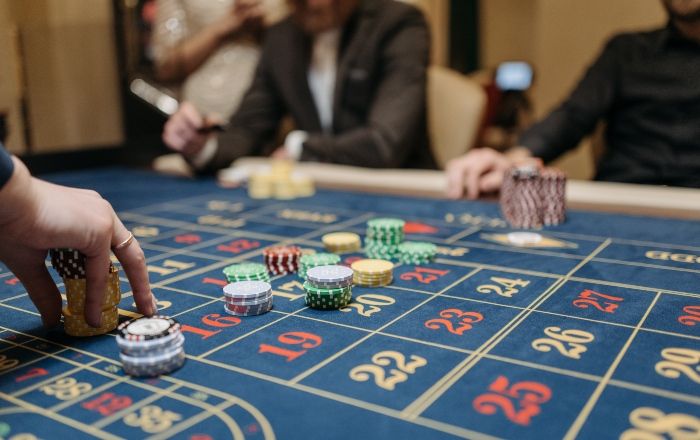
Casino games have long been a engaging source of amusement, drawing countless of players from diverse cultures around the globe. From the opulent casinos of Las Vegas to the busy gambling halls of Macau, these games serve as a bridge that brings together people across a variety of backgrounds. The allure of chance, skill, and risk entices not only those hoping to win money but also those seeking a sense of community.
The influence of casino games extends well beyond the gaming floor. BJ88 They often embody the cultural standards and traditions of the societies in which they prosper. Games such as poker, pontoon, and the spinning wheel have embedded themselves into the fabric of mainstream culture, influencing various aspects from movies to style. As we explore this captivating intersection of chance and culture, we can gain insights into how these games shape and are affected by the world around us.
Historical Development of Gambling Games
The beginnings of casino activities can be tracked back to old cultures, where betting in different forms was widely practiced. In the East, around 2300 B.C., a form of gambling known as Keno was well-known, while in ancient the Roman Empire, soldiers would frequently bet on the consequences of their matches. The notion of using chance for entertainment and income progressed over the years, leading to the formation of more organized games. By the end of the Middle Ages, betting houses began to surface in European nations, notably in the Italian peninsula, which introduced early forms of well-liked games still played today.
As betting expanded recognition in European regions, the 17th and 18th centuries saw the emergence of gaming houses as specialized locations for gaming. The initial official casino, the Ridotto, was founded in the Venetian city in the year 1638, featuring games like Baccarat and Faro. This era marked a crucial turning point, as casinos began to draw not just the wealthy but also the burgeoning middle class. The refinement of games evolved, leading to the development of new regulations and variations that enhanced the play experience.
In the 19th century, the industrial revolution and shifts in societal conventions additionally transformed the environment of gaming activities. The launch of roulette and modern gaming machines drew a more diverse audience, and casinos became seen as legitimate forms of entertainment. This period witnessed the worldwide proliferation of casino activities, as casinos extended from the continent to the New World, culminating in the development of the iconic Las Vegas Strip in the twentieth century. The progress of gambling games has persisted into the current era, incorporating new technologies and online platforms, making them accessible to a global market.
# Cultural Relevance across Diverse Cultures
Casino activities have profound cultural importance in a multitude of communities throughout the globe. For instance, in Las Vegas, the very core of the urban landscape is woven around casinos, where gambling is not just a pastime but a central aspect of entertainment and community life. The bright lights and lively atmosphere attract millions, showcasing how casino games can influence local financial landscapes and cultural identities. This environment transforms the notion of relaxation into an engaging event that shapes apparel, melodies, and even film.
In contrast, some cultures view gambling with an air of caution, seeing it through the lens of ethical considerations and heritage. For example, in numerous Eastern cultures, games like Mahjongg and Pai Gow are steeped in history and carry significant social relevance. These games are often played during gatherings and celebrations, fostering social ties and reinforcing familial ties. The act of participating in these games goes beyond mere entertainment, reflecting ethics such as deference to seniors and the importance of collective enjoyment.
Simultaneously, in Western countries such as Monte Carlo and Italy, gambling activities serve as symbols of luxury and refinement. The stylish atmosphere of these locations attracts both tourists and native inhabitants, upholding a sense of prestige and exclusivity. The art of Texas Hold’em and the strategic features of games like the game of baccarat are esteemed, molding social dynamics and cultivating an attraction that enthralls a varied audience. This highlights how casino games can both reflect and mold societal views towards danger, gain, and relationship building.
Financial Influence and Tourism
Casino games play a crucial role in the financial context of many regions, particularly those that depend significantly on tourism. The revenue generated from casino operations fuels local economies, creating jobs not only within the casinos but also but also in connected industries such as hospitality, dining, and entertainment. This surge of tourists, drawn by the allure of games and the overall casino experience, stimulates spending across multiple businesses, contributing to the economic vitality of the area.
The existence of casinos often leads to the development of facilities, including hotels, transportation systems, and recreational facilities. These developments are essential in improving the overall tourist experience, making destinations more appealing to visitors. Additionally, many casinos invest in local communities through support of events and philanthropic activities, further embedding themselves into the social fabric of the region. Such contribution not only supports economic growth but also fosters a positive image of the casino industry.
Moreover, the worldwide appeal of casino games drives competitive tourism, with regions vying to attract gamblers from around the world. Iconic destinations like Las Vegas and Macau have become identifiable with casino culture, drawing millions annually. This competitive edge encourages creativity and variety within the gaming industry, influencing trends in leisure and hospitality that extend beyond their limits. The ripple effects of this visitor influx extend far, impacting local financial health and cultural interactions on a global scale.
